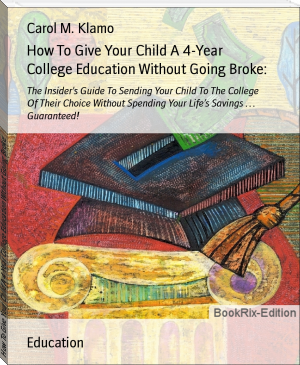How To Give Your Child A 4-Year College Education Without Going Broke: - Carol M. Klamo (top novels to read txt) 📗

- Author: Carol M. Klamo
Book online «How To Give Your Child A 4-Year College Education Without Going Broke: - Carol M. Klamo (top novels to read txt) 📗». Author Carol M. Klamo
Here’s a sample of what it looks like:
Eligibility Information:
Estimated
Expected Family Contribution
(EFC) = 07480
What this means is that according to the Federal formulas, the government expects you to contribute $7,480 towards the first year of college for your child.
Unfortunately, the Federal EFC is not the number most private colleges and universities use. Most of the schools that asked you to fill out a CSS Financial Aid Profile form will be using a different formula to calculate how much you should be paying towards college costs called the “Institutional Methodology.” This figure normally differs from the Federal EFC.
Here’s What You Need To Do If You Have To Revise Or Update Your Information...
If you estimated your income and tax information when you originally filled out your financial aid forms, you must revise or update your information as soon as possible.
Since most people don’t file their tax returns until April 15th, it would be a good idea to meet with your accountant or tax preparer and explain that you need to update your income tax information on your child’s financial aid forms immediately.
Tell your accountant you can’t wait until April 15th, or it will hurt your chances of receiving financial aid. This should do the trick.
Anyway, after you’ve received your final updated income and tax information, it’s time to correct it on your SAR.
You will now need to revisit the FAFSA web site, login and follow the prompts to update your information.
Look for the questions you estimated when you filed your FAFSA and update the information under “The correct answer is” side.
Once you’ve completed this process, you will receive confirmation of your changes and within 72 hours you should have an updated SAR ready for your review. This information should also be electronically updated to all the same schools that you originally requested to receive your information.
You may also want to call the Financial Aid Offices at all of the colleges you applied to, and they will tell you to do one of three things:
1. They have received the information and do not need any other information from you at this time.
2. They have received the information and you have been selected for the "verification" process and you will be required to submit additional financial documentation.
3. They have not received any of the updated information and they will instruct you as to what to do at that time.
When you speak to the financial aid officers, ask if they want an original copy of the SAR.
With all of your documentation, I recommend that you keep copies and check and re-check your information to ensure accuracy. There may be multiple requests for information on various different forms and you want to be sure you have reported accurate information across all the requests so as not to be "flagged" for additional verification procedures.
After you’ve completed all your paperwork, the next step is to wait to hear back from each of the schools your child is accepted to in the form of an award letter.
Several of the schools will also require you to send in a completed copy of your tax return before they will give you a financial aid package.
In light of this, I highly recommend you get your taxes done as soon as humanly possible. In January, you can get the ball rolling by filing your FAFSA form with estimated information but the sooner you get your information updated, the better your chances of receiving your award offers early.
Also, irregardless of your timing and accuracy some financial aid forms will be randomly selected for “verification” which is the equivalent of being selected for an audit by the IRS.
If you are selected for verification, you will be asked to supply a copy of your tax return, and documentation on the income and assets you listed.
But, don’t worry if you are selected for verification. It is very commonplace, and a lot less intrusive than an IRS Audit.
If you follow the step-by-step plan I’ve outlined above, everything should proceed smoothly and award letters will start arriving around April or May.
Chapter #8
“How To Take Control Of The College Funding Process And Get The Maximum Amount Of Money For Your Child’s College Education...
In this chapter, we’re going to talk about two families - The Greens and The Smiths.
Both families started out with roughly the same financial situation, and their children applied to the same colleges since they both had B averages and 1,550 on their SAT’s.
However, that is where the similarities end.
The Greens started to think about the college funding process around December of their son, Timothy’s, senior year of high school.
John and Mary Green had a combined income of $60,000, $40,000 in savings, a home worth approximately $150,000, and a rental property worth $60,000.
They had also put $20,000 in savings into Timothy’s name because their accountant told them they would save money on taxes.
They waited until January and filled out the financial aid forms themselves.
They got their Student Aid Report (this is what the government sends you after you file a financial aid form) back around the middle of February.
Much to their surprise, this complicated report told them the following things: (1) They had made several mistakes in filling out the financial aid forms and now needed to re-file a new set of forms with the corrected information; (2) It also said their family contribution (the minimum amount they would have to pay at any school) was $18,000.
John and Mary stared at the report in amazement.
John exclaimed, “You mean to tell me that two average folks making a modest income with very little savings have to pay this much? Where in the world do they expect us to get all this money from? We’re already up to our eyeballs in bills, and our savings was supposed to be for retirement - How in the world are we going to send Timothy to college?”
What the Greens weren’t aware of was that financial aid is awarded on a first come, first served basis. Since they had to re-submit the financial aid forms, they lost valuable time and ended up losing a lot of college funding.
Around April, Timothy started getting award letters back from the colleges he had applied to.
He got his first one back from Ithaca College, and said to his parents, “This can’t be! The government report said we would have to pay $18,000, but this award letter says we have to come up with $22,000. But that’s not the worst of it! The money they did offer us is almost all loans with the exception of a $500 grant - How in the world are you guys ever going to be able to afford to send me to college?”
Timothy got the rest of his award letters from the other schools. Unfortunately, most of them were just as bad as Ithaca College.
The Greens had a tough decision to make - should they tell Timothy they couldn’t afford to pay for his college education, or should they sacrifice.
They decided to use their life’s savings to pay for the first year, and then they would take out a home equity loan to help pay for years 2, 3, and 4.
* * *
The story of the Smith’s turned out a lot differently.
They also had a combined income of $60,000, savings of $40,000, a home worth $150,000, and a rental property.
However, they decided to take control of the process.
Mr. Smith decided to use a local college-funding expert who explained the process to him and his wife and told him how to increase his eligibility for financial aid.
The first thing he told the Smith’s to do was set up their savings and investments in the most favorable terms legally allowable before filling out the financial aid forms.
The next thing the college funding expert showed them was how to properly value their home for the financial aid forms. He explained that the government uses a special formula called the “Housing Index Multiplier” which is based on the year you purchased your home, and the purchase price. Most people have no earthly idea what this formula is, and end up over-valuing their home, which hurts their eligibility for funding.
The next thing the expert showed the Smiths was which schools their son, Peter, had the best shot of getting money from.
He explained how some schools have a lot of money to give out while others have virtually nothing.
The expert said “You must know which schools can give you the most money before you apply - not after. This way you won’t be surprised at the end of the year.”
The third thing the expert helped them with was filling out the forms. The Smiths were amazed when he told them that many of the forms go in with errors or inconsistencies. He went on to say, “If your form goes in wrong, you have to re-submit it again and you could potentially lose thousands in funding.”
Joe and Cindy Smith wondered whether all of this planning would pay off.
The first good sign was when they received their Student Aid Report. It said their family contribution was only $8,000. This was $10,000 less than what the Greens had to pay - all because the Smiths took control of the process before they filed their forms.
They also discovered that their forms went in “error-free” so they wouldn’t have to re-submit any forms.
But the best was yet to come.
Their son, Peter, started to get his award letters back from the colleges he applied to.
He had also applied to Ithaca. Except, unlike Timothy, Ithaca said he would only have to pay the amount of his family contribution, and they would cover all expenses above and beyond that. He also received mostly grant money and only one loan.
Peter also started receiving award letters from the rest of the schools, and the monies offered were almost exactly what the expert told him to expect.
Joe and Cindy had an easy decision to make. All they had to do was come up with their family contribution, and most of the schools covered the rest of the expenses.
Peter ended up going to Ithaca, and his parents didn’t have to spend their life’s savings or mortgage their house to the hilt to do it.
The Smiths lived happily ever after.
* * *
What was the difference between these two families?
On the surface, they both looked the same. They had similar incomes, assets, and both students had similar grades and SAT scores.
The only difference was that The Smith’s took control of the process instead of sitting back and hoping for the best.





Comments (0)